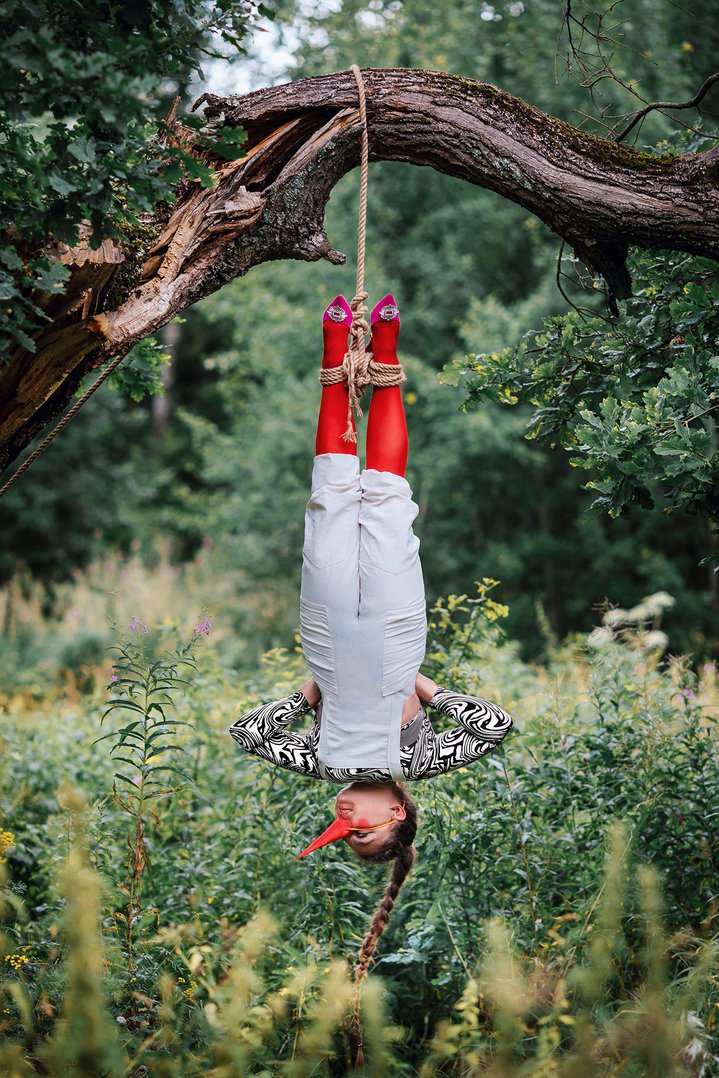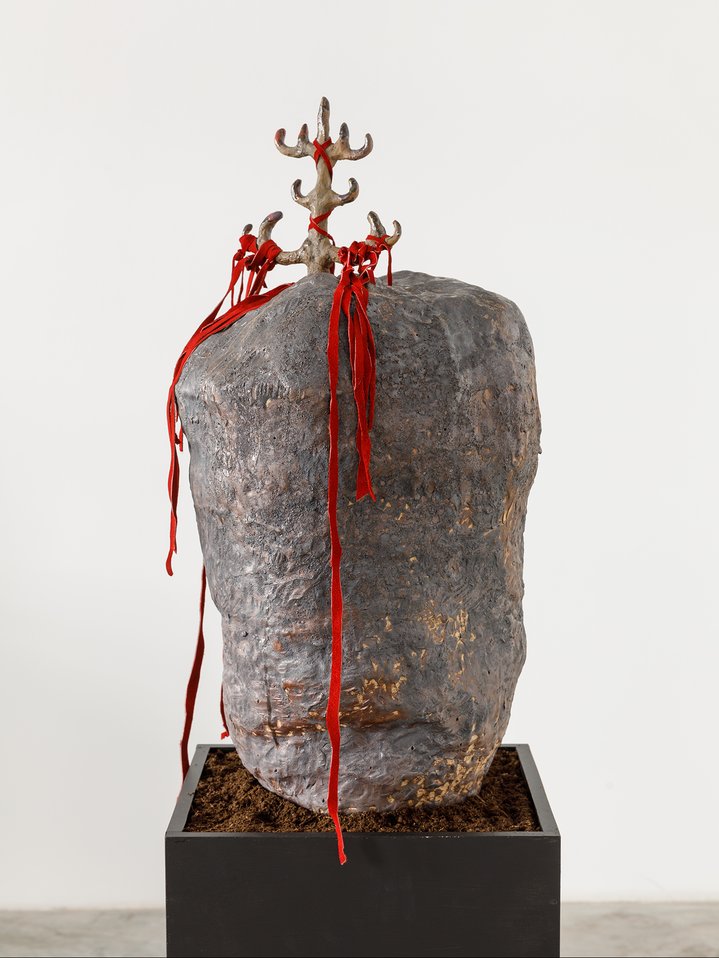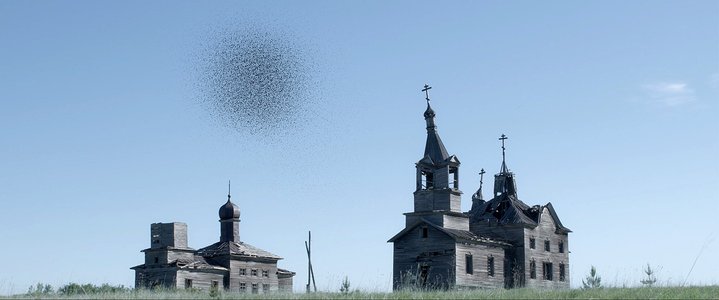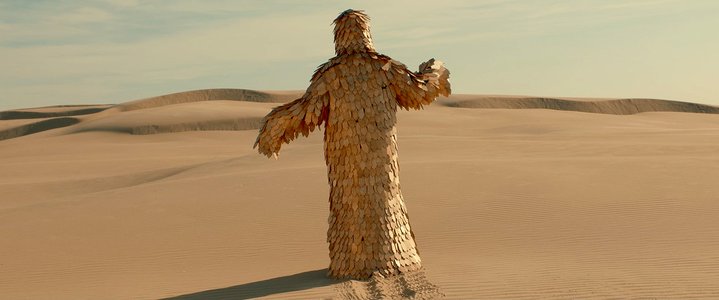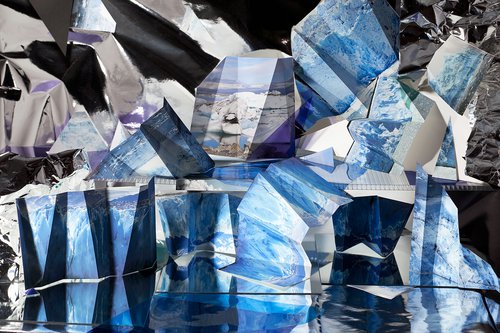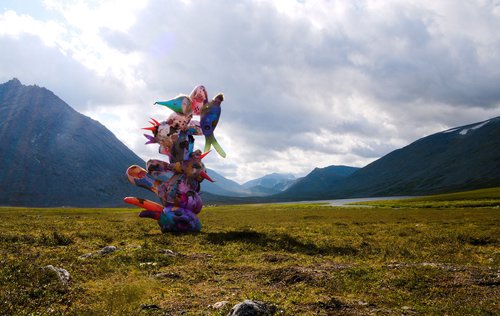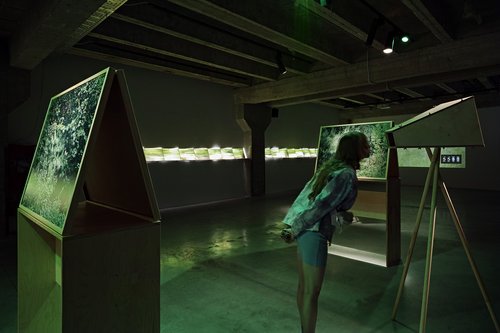Ulyana Podkorytova: A Tale of Slow Time

Ulyana Podkorytova. Photo from the set of the film 'Tamotka', the film was shot as part of the project 'When Gondola Engines Were Taken to Bits – A Carnival in Four Acts' at GES-2, 2021, photo by Pavel Smirnov
Artist Ulyana Podkorytova has developed a mythical universe based on the old legends and rituals of the Russian North. Yet as her current exhibition ‘Fast Life, Slow World’ at the Myth Gallery in St. Petersburg suggests, has the time has come for the horrors of fairytales to come true?
The Myth gallery in St Petersburg has opened a new exhibiton about mystical signs, fairy tales, fears and superstitions, all esoteric yet popular themes for which the gallery is already known. This time it focusses on a very personal myth: that of Russian artist Ulyana Podkorytova (b. 1984), whose work with images drawn from the folklore of the Russian North and overlaid with the post-folklore of blogs, forums and esoteric shows, means she is no newcomer at the gallery. The artist’s video installations, graphic works and art objects have already been shown there in group exhibitions, including ‘Very Strange Stories’ in 2019 and ‘Vague Images’ earlier this year. However, here in the show ‘Fast Life, Slow World’, Podkorytova’s artistic vision fills the space weaving a narrative which stands on its own.
The content of the exhibition, which was planned more than half a year ago, evolved dramatically over time. Initial plans had to be shelved because of the current situation, and although working with the same material and media as before, the artist adapted them according to her new sense of the world. Some characters in the works are recognisable from previous projects, yet their inherent sense of the comic, has been replaced by vulnerability and a sense of unease. Podkorytova’s alter ego, a once all powerful miracle maker called ‘Gertrude the Ferocious’ with a six metre long braid, now resembles a child, depicted as if drawn by a child. She is sleeping and has strange dreams. There are also two heads which are standing only on their braids, familiar from Podkorytova’s project Rai’ok (Paradise, OK) in 2020, crying bloody tears. They are placed at the entrance, greeting the exhibition viewers. This bizarre yet powerful image from the artist’s imagination seems more topical than ever: “I am absolutely certain that I did not choose this horrible character by accident. I found it in a series of old tales about soldiers, where the protagonists are usually a Soldier and the old witch Baba Yaga, or a Soldier and Death. Almost every tale starts out with the King sending the Soldier off to war. I don’t think it is necessary to explain why this is relavant now. In one such tale, a soldier, returning from the battlefield, chopped off Baba Yaga’s head, and she got up on her braids and ran after him to continue fighting. For the last few months all we have been talking about is what will happen next: will the soldiers bring the death they have sown when they return to their families and neighbours?”
Maybe the photo of the artist herself hanging in the air hinting at “The Hanged Man” Tarot card can provide an answer? This card does not mean death, but points to the trials of life, our doubts, a life of uncertainty and our own choices, on which nothing necessarily depends. The exhibition, although mostly composed of ritualistic objects, does not offer any prophesies or reassurances. We have to live in a rapidly changing world, yet one which is also slow and ancient, observing it and doing only what is possible. The artist says: “In the magical incantations of the northern regions of Russia the phrase ‘don’t look back and don’t look away’ is used often. In other worlds, live in the here and now, but learn from nature, greet the stones and trees in the forest, remember that without the past the future cannot grow.”
And yet, ominously, there is a ceramic hand on the wall pointing its finger, treatening to turn back time. The power of time in Podkorytova's mythological system may (or may not) be broken by sacred stones or deities painted on canvases resembling both Russian folk prints, called Lubki, and Saami tambourines. It is no coincidence that in the same tales of the soldiers the cunning Soldier, who belonged to neither heaven nor hell, was driven away by a drum on which the skin of a devil was stretched. On one of these canvases, the artist painted a mythical beast similar to the creations of the Ukrainian naive painter Maria Priymachenko (1908–1997), only instead of her vibrant bright colours Podkorytova uses an earthy palette. The idea of a bloody hand made of clay came to the artist in the small town of Kargopol in the North of Russia: “In one of the churches there I saw a medieval sculpture under the dome. It was a huge log, with a hand carved at the end. The fist was placed very high, almost taking the spot traditionally reserved for Christ the Pantocrator. Everyone who came into the church found themselves in a setting in which it would have been impossible not to be terrified by something huge and great”.
While the current exhibition project in St Petersburg contains references to the monuments of Kargopol, at the exhibition ‘Divovaniye. Discovery of the North’ in Kargopol you can still see her video work ‘Tamotka’ and the costumes used during its creation, filmed in the Northern villages of Chakola and Shoina. This video, based on a book called the ‘Morphology of Fairy Tales’ by Soviet philologist and folklorist Vladimir Propp (1895–1970), will be shown at the Bodo Biennale in Norway in September. During this Biennale, Podkorytova will also do a vocal performance at the Jektefartsmuseet on the 2nd of September. For twenty minutes she will perform a mix of five ritual songs taken from different parts of Russia. “I hope that they will be sung for the benefit of all sufferers on Earth”, she says.
Ulyana Podkorytova’s tales are neither escapism, nor an attempt to invent or recreate a Russian national identity. The artist, whose fictional alter ego usually fights against globalism, in fact, by means of myth-making herself creates an alternative holistic world uniting and reconciling beliefs, rituals and folklore of different nations.
Ulyana Podkorytova. Fast Life – Slow World
St. Petersburg, Russia
August 20 – October 19, 2022
Bodo Biennale
Bodo, Norway
September 1–4, 2022
Divovanie. Discovery of the North
Kargopol Historical-Architectural and Art Museum
Kargopol, Russia
July 2 – September 9, 2022







